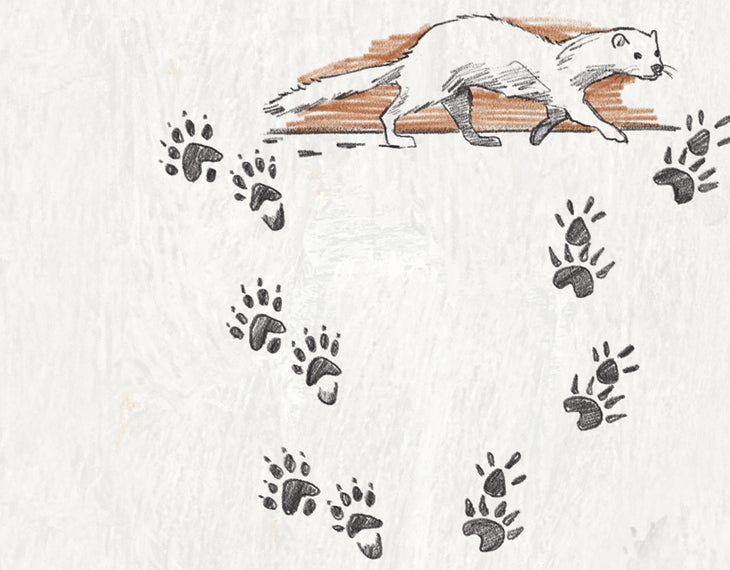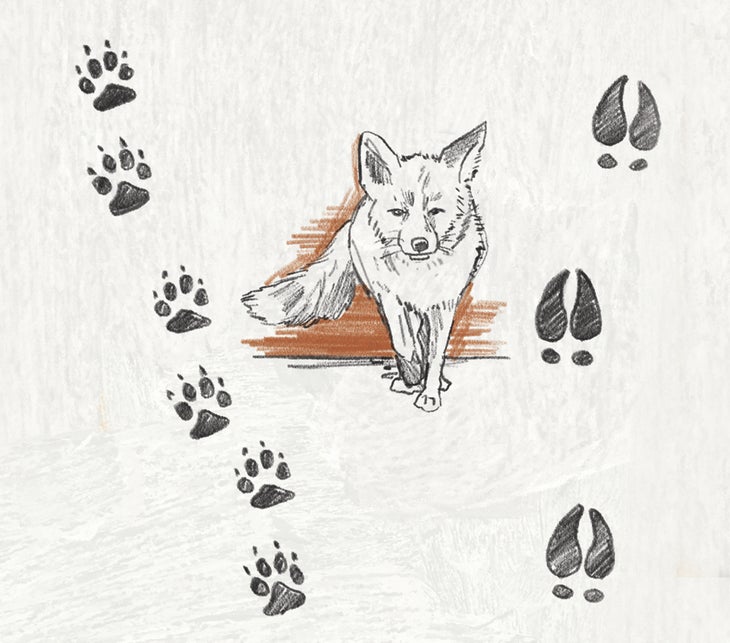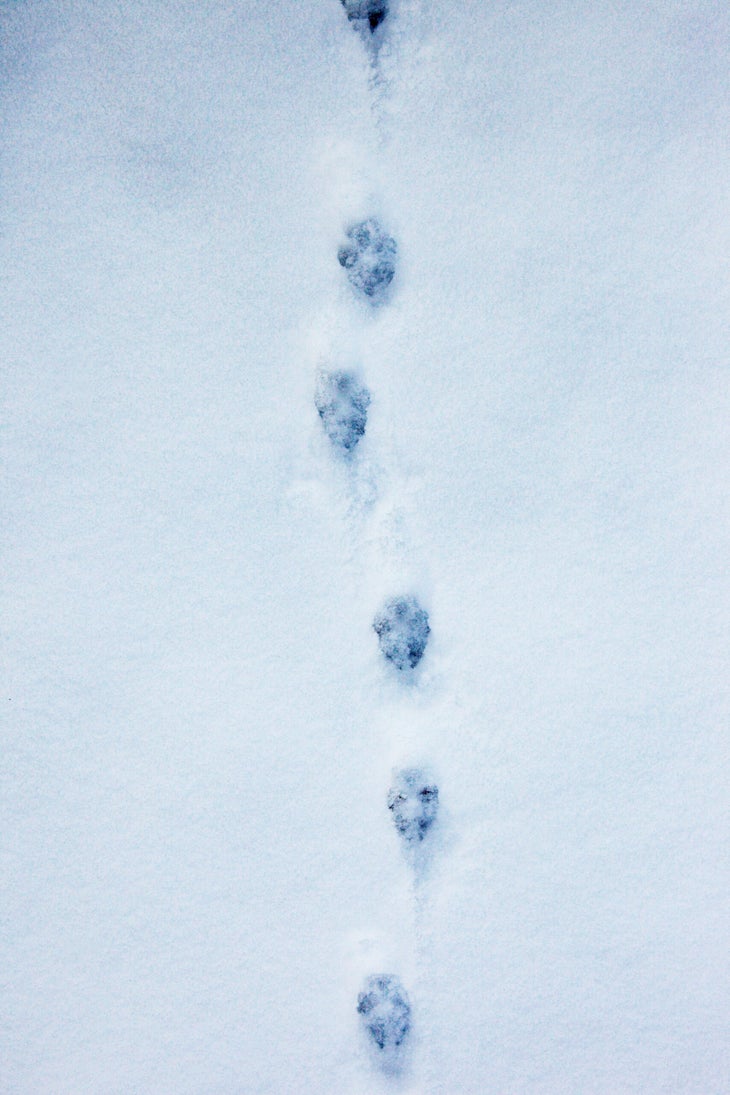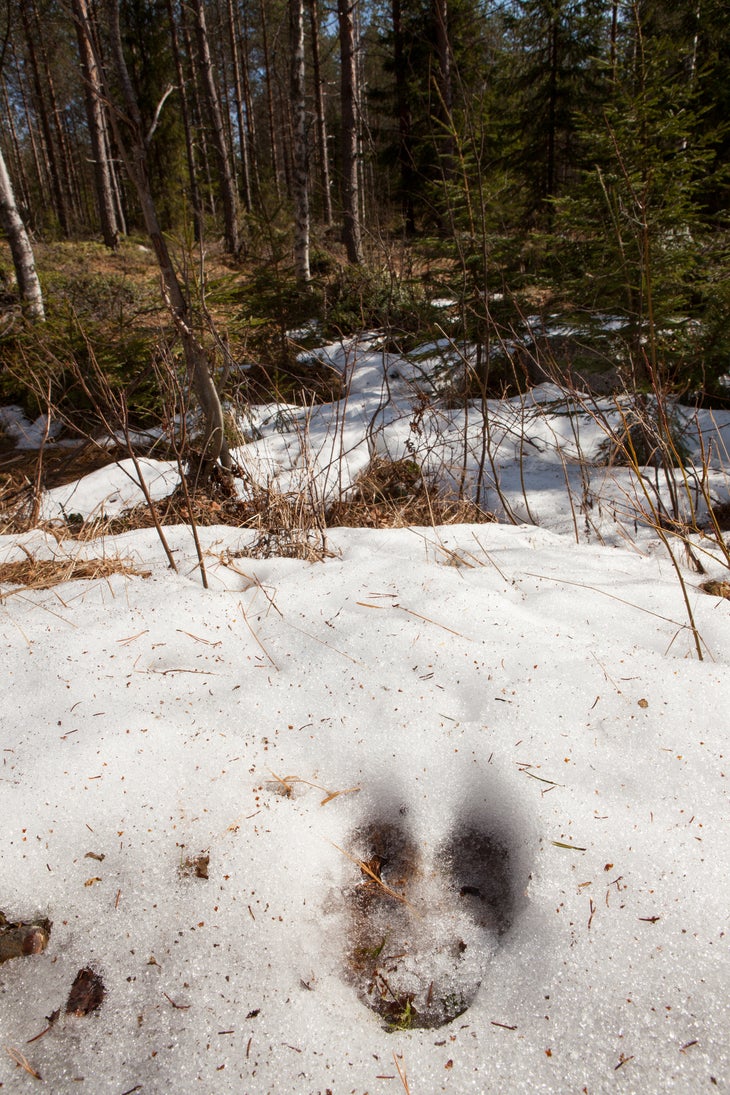Products You May Like
Get access to everything we publish when you
sign up for Outside+.
Winter is an especially great time to go hunting for animal tracks in the snow. In summer, animals’ prints can be difficult to spot on packed dirt trails. But snow preserves them, allowing hikers to experience the busyness of the forest in a new way. Follow these tips to spot and identify animal tracks in the snow.
Research Common Animal Tracks
The types of tracks you can find depends on where you’re hiking, and a little bit of advance research will give you the skills you need to tell them apart from each other. Before hitting the trail, read about the animals that frequent the area and what their tracks look like. This will help you narrow in on an identification. As a beginner, don’t expect to be able to definitely identify animal tracks on your first try. Consulting guidebooks or mobile apps like iTrack Wildlife Lite can help you begin to recognize paw, hoof, and footprints. Keep in mind that not all of the animals you see in summer will be active during the colder months; in contrast, you may have a better chance of locating animals that camouflage better in summer. As you get started, focus more on observation; precise identifying is a skill that will come with practice.
Time it Right

Not all snow conditions are equally suited for animal tracking; in deep snow, large animals will sink—just like postholing hikers—rendering their prints difficult to identify. Animal tracks hold their shape best in thin, wet layers of snow. Loose, dry snow often won’t hold the details of prints well enough to identify them by shape.
In addition, animals tend to hunker down during blizzards. So, during a snowstorm is rarely a good time to hunt for fresh tracks. Wait until after a storm has ceased, when animals will emerge looking for food and leave evidence of their wanderings in the fresh snow. But don’t wait too long: Warm temperatures and direct sun can melt out animal prints in the snow, warping and degrading them.
Identify Animal Tracks in the Snow by Looking at Walking Patterns
Don’t just look for the shape of prints, but the entire track gait. “The track gait is the full stride of multiple tracks that help you observe how the animal is moving,” says Tom Manitta, outreach coordinator for the Adirondack Mountain Club. Animals move in all sorts of unique ways, and these movements leave behind valuable evidence for trackers. Manitta distinguishes between groups of animals he refers to as hoppers, bounders, amblers, and perfect steppers. These four categories don’t necessarily cover every animal track you might encounter on the trail, but they’re a great place for beginner trackers to start, says Manitta.
Snow conditions can make it hard to identify individual prints, so understanding track gaits and looking for patterns can be even more useful than memorizing dozens of print shapes. By observing patterns, you can discern the size of the tracks and how an animal moves, which will help you narrow in on an identification.
Hoppers: Rabbits, Hares

Squirrels and snowshoe hares belong to the hoppers. As it hops, an animal’s smaller front feet tend to land first, followed by the larger back feet, which plant ahead of the front feet. Picture a rabbit planting its front paws and swinging its back paws in front as it bounces through the snow. Clumps of four prints indicate that a hopper has passed through.
Bounders: Weasels, Mink

These animals have long bodies and short legs—like weasels and mink. Bounders’ tracks show where the animal’s back feet landed close to the front feet.
Amblers: Bears, Skunks, Porcupines

These prints are recognizable by their side-to-side pattern, which shows how the animal waddles through the snow. Black bears, skunks, and porcupines are among the most common amblers. Look for front and rear pairs, as shown, to identify an ambler.
Perfect Steppers: Coyotes, Foxes, Moose

These walkers place their rear foot inside the print of the front foot, forming a series of single tracks. Straight line animal tracks in snow indicate a perfect stepper, such as a moose or a fox, has passed through.
Search for Clues
When attempting to identify animal tracks in the snow, look for additional hints like fur, scat, and the starting and stopping points of tracks. If you can identify a burrow or den that an animal has emerged from or walked toward, you might have a better shot at identifying it.
Photos of Common Animal Tracks
The following prints are commonly found across North America. Learn how to recognize them so you can identify them on your next winter hike.
Snowshoe Hare
Notice the track gait in this image, where the hare’s large back feet landed in front of its smaller front feet. In wetter snow, you may be able to distinguish four toes on the back feet.

Fox
A straight line of prints like the one shown below indicates perfect stepping. Fox tracks are small—usually 1.75 to 2.5 inches in diameter, and often ill-defined, as foxes have furry paws. Foxes often drag their feet, resulting in a streaky track like the one below.

Turkey
Wild turkey prints tend to be 3.5 to 4.5 inches in length. You can determine how many turkeys are in a flock by counting the sets of tracks.

Moose
Moose tracks look very similar to those of deer and elk in shape, but the size can help you determine which ungulate made the print you’re looking at. Moose prints tend to be 5 to 6 inches in length, while elk leave roughly 4-inch tracks. Deer prints tend to be roughly 3 inches long.

Mountain Lion
Mountain lion or cougar tracks tend to be large—up to 3.75 inches in diameter. Look for four toe prints with no claws, and three lobes toward the back of the paw. (Canine prints, like wolves and coyotes, only have two lobes on the back.)

Stay Safe and Comfortable
When observing animal tracks in the snow, you may spend more time not moving than on a regular winter hike. Pack extra layers of warm clothing. If you plan to consult a guidebook or app, or need your fingers to take photos, wear a pair of light liner gloves so you won’t have to expose your bare hands to the cold when taking off heavy mittens. When hiking in the snow, always make sure you’ve packed the proper traction for current trail conditions. In the evening or on dark, cloudy days, pack a headlamp to help you get a better view of any animal prints you find. In especially cold weather, snap photos of animal tracks on your phone. You can study them in detail once you get home
Respect Wildlife
Chances are you won’t actually encounter the animal that left the tracks you’re observing. But if you do, remember to keep a safe distance. Not sure if you’re far enough away? Use Leave No Trace’s rule of thumb: Make a thumbs up and extend your arm all the way in front of you. Close one eye and try to cover the animal you can see with your extended thumb. If the animal is hidden behind you’re thumb, you’re a safe enough distance from it. If you can still see the animal behind your thumb, move farther away.
Did You Know?
Now that you’ve spotted a set of animal tracks in the snow, impress your hiking partners with these fun facts about the creature that left them.
- You can still track hibernators. Some mammals like skunks hibernate intermittently. You may spot their tracks in the snow on warm days when they emerge from their hideaways to find food.
- Foxes, wolves, coyotes, and dogs are all part of the canid family, making their tracks difficult to distinguish from one another. Size can be one indicator: Wolf and dog prints tend to be the largest, followed by coyote and then fox prints. The direction of travel of the tracks is a clue, too (dogs tend to meander, while wolves follow straight paths).
- Squirrel prints are commonly found in winter; the critters don’t hibernate, but emerge now and then from their warm homes. A squirrel’s front teeth never stop growing, but are constantly being worn down from nibbling on nuts and seeds.
- You might spot its tracks, but good luck catching a glimpse of the snowshoe hare. This hopper’s fur changes color from season to season, from brown in the summer to white in the winter to aid in camouflage.
- Turkey tracks, which are recognizable as three lines that meet at a point, are easy to spot in the snow. But turkey droppings can tell you even more about the large birds. The shape of turkey poop can tell you whether a male or female left it: Scat from a gobbler (male turkey) looks like the letter J, while that from a hen more closely represents the poop emoji.
